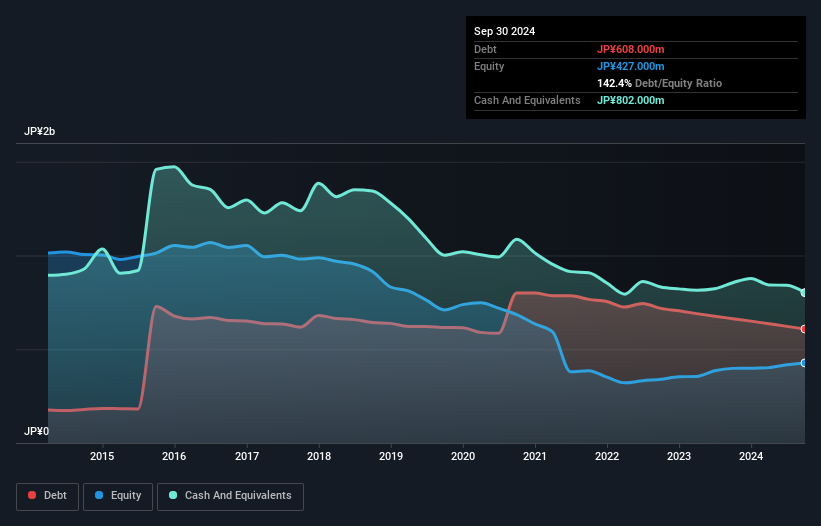
The external fund manager backed by Berkshire Hathaway's Charlie Munger, Li Lu, makes no bones about it when he says 'The biggest investment risk is not the volatility of prices, but whether you will suffer a permanent loss of capital.' It's only natural to consider a company's balance sheet when you examine how risky it is, since debt is often involved when a business collapses. As with many other companies PA Co., Ltd. (TSE:4766) makes use of debt. But should shareholders be worried about its use of debt?
When Is Debt Dangerous?
Debt and other liabilities become risky for a business when it cannot easily fulfill those obligations, either with free cash flow or by raising capital at an attractive price. In the worst case scenario, a company can go bankrupt if it cannot pay its creditors. However, a more frequent (but still costly) occurrence is where a company must issue shares at bargain-basement prices, permanently diluting shareholders, just to shore up its balance sheet. Of course, plenty of companies use debt to fund growth, without any negative consequences. The first thing to do when considering how much debt a business uses is to look at its cash and debt together.
View our latest analysis for PA
What Is PA's Debt?
You can click the graphic below for the historical numbers, but it shows that PA had JP¥608.0m of debt in September 2024, down from JP¥663.0m, one year before. But on the other hand it also has JP¥802.0m in cash, leading to a JP¥194.0m net cash position.

How Healthy Is PA's Balance Sheet?
According to the last reported balance sheet, PA had liabilities of JP¥680.0m due within 12 months, and liabilities of JP¥197.0m due beyond 12 months. Offsetting these obligations, it had cash of JP¥802.0m as well as receivables valued at JP¥168.0m due within 12 months. So it actually has JP¥93.0m more liquid assets than total liabilities.
This surplus suggests that PA has a conservative balance sheet, and could probably eliminate its debt without much difficulty. Succinctly put, PA boasts net cash, so it's fair to say it does not have a heavy debt load!
But the bad news is that PA has seen its EBIT plunge 15% in the last twelve months. We think hat kind of performance, if repeated frequently, could well lead to difficulties for the stock. When analysing debt levels, the balance sheet is the obvious place to start. But you can't view debt in total isolation; since PA will need earnings to service that debt. So when considering debt, it's definitely worth looking at the earnings trend. Click here for an interactive snapshot.
But our final consideration is also important, because a company cannot pay debt with paper profits; it needs cold hard cash. PA may have net cash on the balance sheet, but it is still interesting to look at how well the business converts its earnings before interest and tax (EBIT) to free cash flow, because that will influence both its need for, and its capacity to manage debt. During the last three years, PA generated free cash flow amounting to a very robust 90% of its EBIT, more than we'd expect. That positions it well to pay down debt if desirable to do so.
Summing Up
While we empathize with investors who find debt concerning, you should keep in mind that PA has net cash of JP¥194.0m, as well as more liquid assets than liabilities. And it impressed us with free cash flow of JP¥76m, being 90% of its EBIT. So we don't think PA's use of debt is risky. When analysing debt levels, the balance sheet is the obvious place to start. But ultimately, every company can contain risks that exist outside of the balance sheet. To that end, you should be aware of the 3 warning signs we've spotted with PA .
If you're interested in investing in businesses that can grow profits without the burden of debt, then check out this free list of growing businesses that have net cash on the balance sheet.
New: Manage All Your Stock Portfolios in One Place
We've created the ultimate portfolio companion for stock investors, and it's free.
• Connect an unlimited number of Portfolios and see your total in one currency
• Be alerted to new Warning Signs or Risks via email or mobile
• Track the Fair Value of your stocks
Have feedback on this article? Concerned about the content? Get in touch with us directly. Alternatively, email editorial-team (at) simplywallst.com.
This article by Simply Wall St is general in nature. We provide commentary based on historical data and analyst forecasts only using an unbiased methodology and our articles are not intended to be financial advice. It does not constitute a recommendation to buy or sell any stock, and does not take account of your objectives, or your financial situation. We aim to bring you long-term focused analysis driven by fundamental data. Note that our analysis may not factor in the latest price-sensitive company announcements or qualitative material. Simply Wall St has no position in any stocks mentioned.
About TSE:4766
PA
Develops revitalization projects for individuals and businesses in Japan.
Adequate balance sheet with acceptable track record.
Market Insights
Community Narratives




